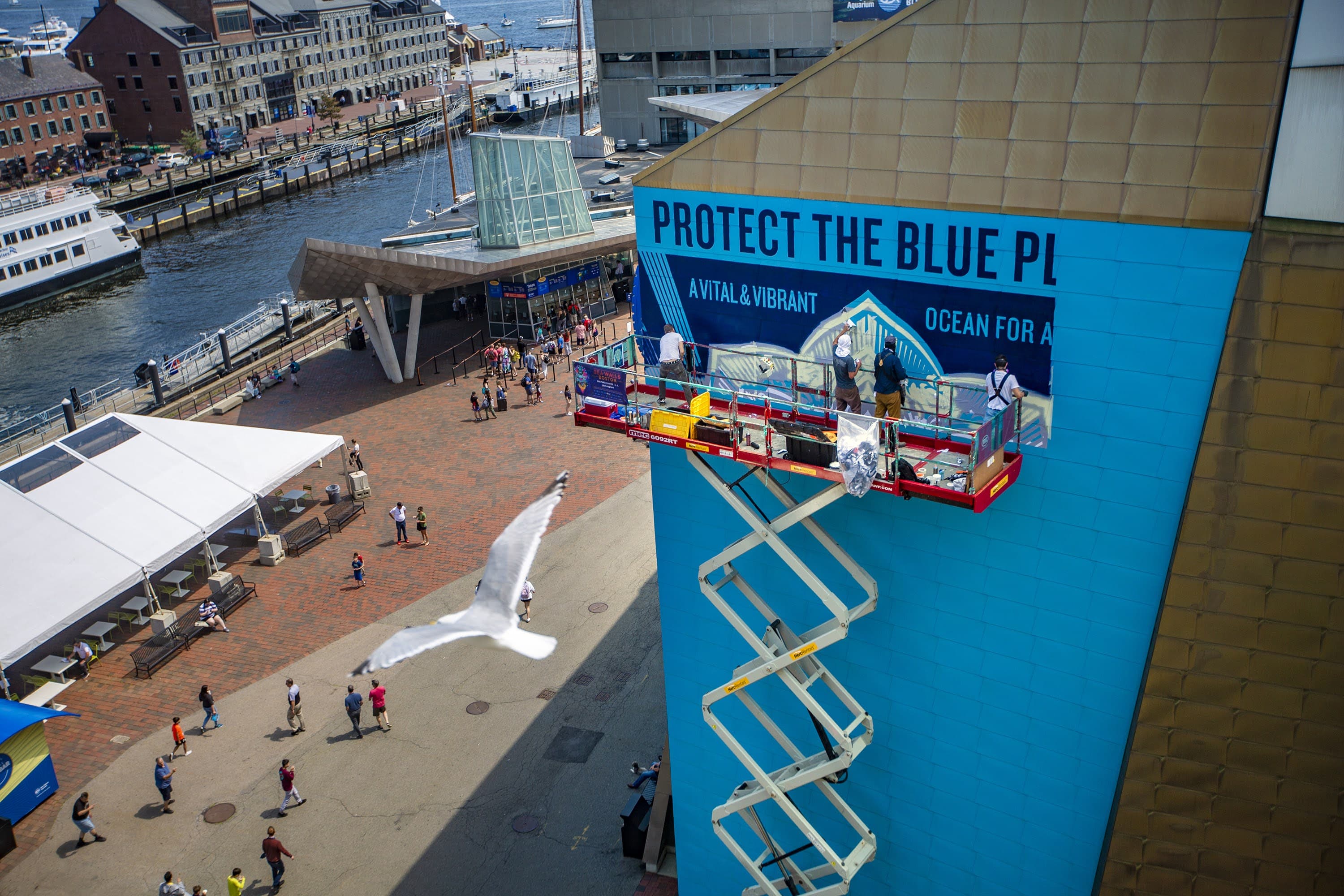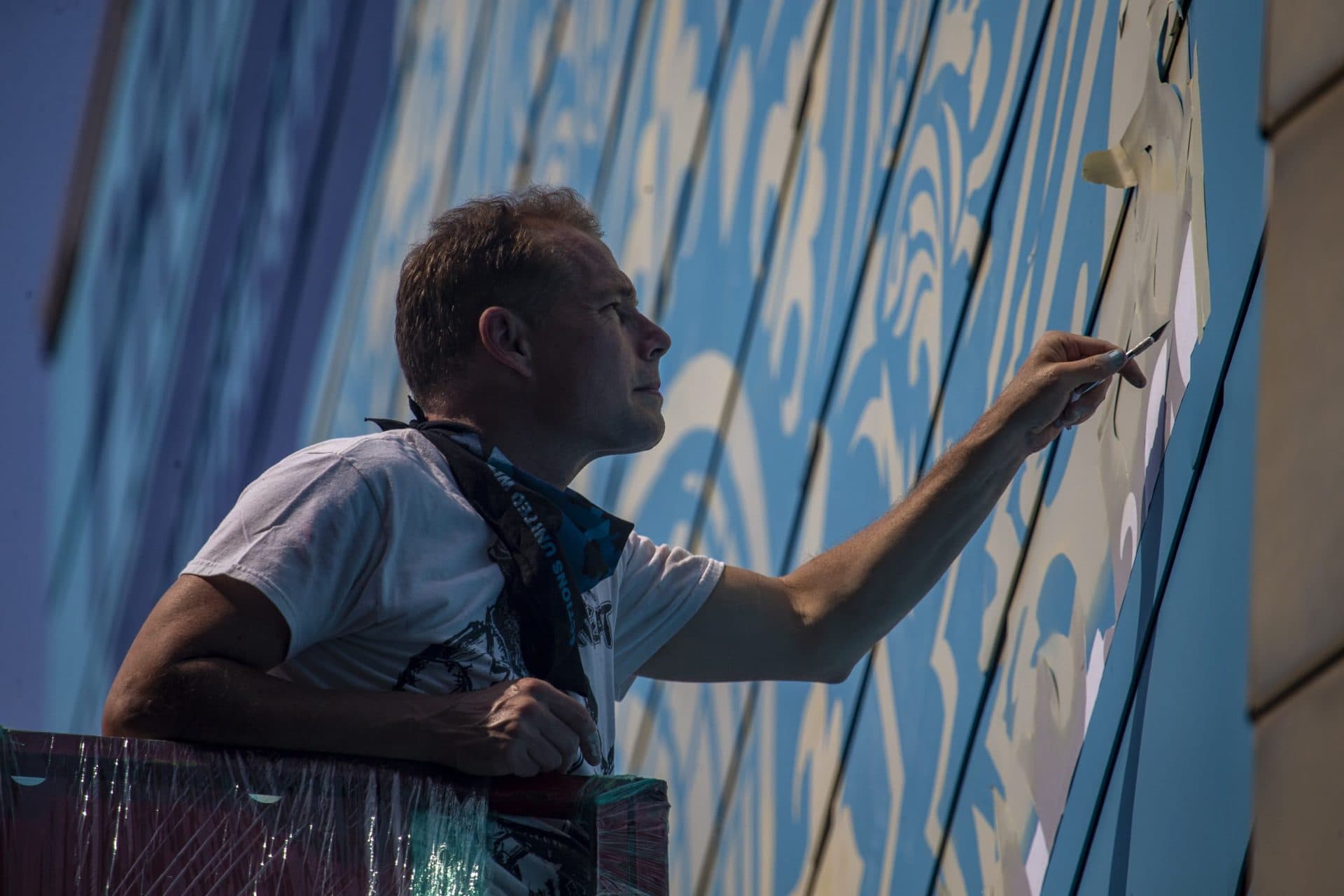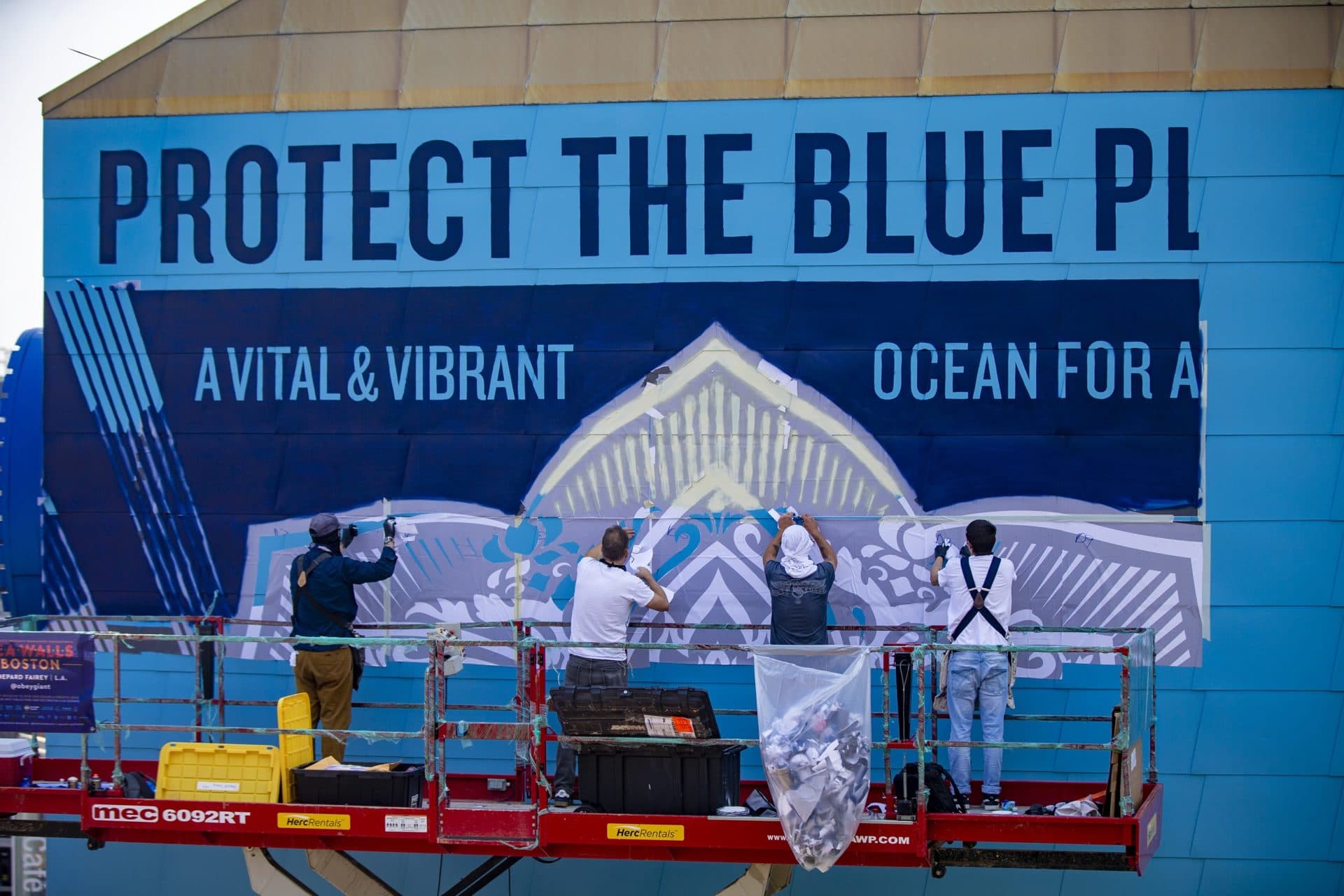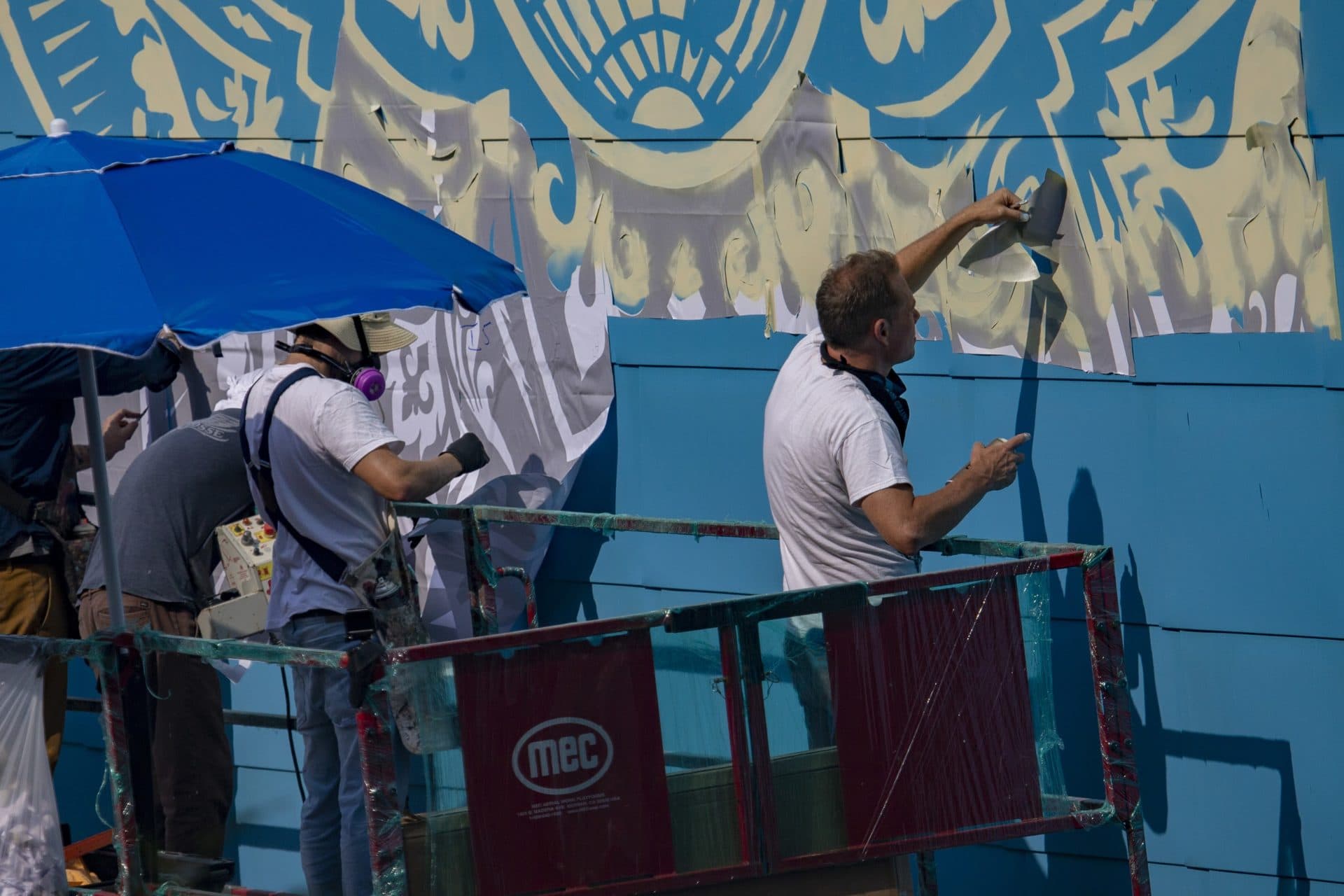Advertisement
From Obey Giant To Oceans, Artist Shepard Fairey Reflects On His First Permanent Mural In Boston

Shepard Fairey has immortalized the likenesses of wrestling icon André the Giant and President Barack Obama in paint. It's safe to say we've all seen the artist's red, white and blue “Hope” image on T-shirts, buildings and front lawns during Obama's 2008 election campaign.
Now, it's the North Atlantic right whale's turn for a treatment by Fairey. The artist-activist executed a three-color mural on the New England Aquarium's Simons Theatre to highlight the endangered species' plight. It's part of a global environmental public art program known as Sea Walls: Artists for Oceans. Fairey's image is one of 13 new advocacy murals that just went up around Boston.
The last time Fairey installed sanctioned public art in Boston, he was arrested. That project was a city-wide activation in 2009 in collaboration with his solo museum exhibition at the Institute of Contemporary Art (ICA). He faced charges of defacing property with unauthorized stickers and posters, one dating back to 2000. Ultimately, Fairey paid a fine for graffiti removal and was banned for two years from bringing art supplies to Boston.
“It's a little bit of street cred and a nice story at this point,” he said when we talked all these years later, “Amusing, even though it was pretty stressful.”
The rest of our conversation is excerpted below. (It's been edited for clarity and length.) After introducing himself as an activist, fine artist, street artist, graphic designer and clothing entrepreneur, Fairey added, “I like to make imagery that talks about social justice issues. That's a big theme of my work.”

Describe your relationship with the ocean.
Shepard Fairey: I grew up in Charleston, South Carolina, which is on the Atlantic and, you know, spent a lot of time in the summers, always at the beach. Then I moved to Rhode Island so I was by the water. Then I moved to California. I've really all my life lived by the water. And my dad is a big outdoorsman and always believed in emphasizing the importance of respecting the ecology of the coast. So, you know, that seemed like him being his usual sort of do-gooder, better-than-everybody else self. But as I got older, I realized there was a real beauty to that. And when I became more engaged in environmental causes the generation gap seemed a little bit smaller between me and my dad.
It's always interesting to think of parental influence, even if it's not direct influence. So this mural, can you describe how the commission came to you?
There's an organization called Pangeaseed that's driving a lot of the artists' participation in this project. I've loved what they've been doing with their painted oceans and printed oceans. So the murals and prints that they're using to create awareness and revenue for ocean preservation — because it falls perfectly in line with the model I'm using for a lot of the work that I do where I make an image about something I care about. I might make a print, I might make a T-shirt I'm going to donate to the NRDC or 350.org or Greenpeace. And so I've been wanting to do something with Pangeaseed for years, and this project happened to come at a time when I had an opening in my schedule.
And also, doing something in Boston on the New England Aquarium is an amazing opportunity. It's a really iconic location that gets a lot of visitors. So it works perfectly for my idea that any message that's worth delivering can be amplified with art.

Can you describe what viewers will see?
It's the North Atlantic right whale at the bottom of the composition — under the water with waves. And then emanating from the whale — not precisely where the blowhole would be, but suggesting that idea — is a "V" which has rays coming up. And the focal point is a mandala with the earth at the center. And it's got some text across the top about vibrant oceans. But really mixed into that mandala, there's flowers, there's ornamentation, but there's also some flames which are the cautionary element about global warming.
This isn't the first piece you've done that confronts climate change.
I just released a print this morning that was about the power of the fossil fuel companies and the need to push back against their disinformation campaigns, their lobbying, their economic leverage, and to ask them with their resources to help the world transition. They've benefited a lot by messing up the atmosphere, and so I think it's only fair. If I can't appeal to legislators to put cap-and-trade in effect, I can at least appeal to voters.
But I've done tons of pieces. During COP21 [United Nations Framework Convention on Climate] in late 2015, I did the "Earth Crisis Globe" that was suspended from the Eiffel Tower. I did a big art show that was all environmentally-themed works in Paris about six months after that. I recently for Greenpeace did a portrait of Joe Biden where he's split down the middle with a blue side and a red side — and factories spewing smoke on one side and green energy on the other side — saying, you know, which future will you deliver for us? It's obviously up to a lot more than just Joe Biden, but Joe Biden is a driver of policy and someone who sets the tone for the conversation.
Advertisement

What is it that art can do, perhaps, that other means of trying to communicate or convince can't? How does art have the power to do something that another mode doesn't?
Art impacts emotionally and study after study have shown that people are driven more by emotion than they are by intellectual ideas, and that intellectual ideas coalesce often around emotions. So there have been people that use that in a really dangerous, manipulative way for their own gain. I would like to use those techniques in a community-oriented, generous spirit for everyone's benefit.
I actually want to make the invisible hand of persuasion visible. I'm very transparent about what I'm doing. Plus, art is great therapy for me. Just working on pictures is soothing for my feelings of powerlessness about all sorts of bad things going on in the world. If I feel like I'm doing something, then there's also the therapy in that. So I can't think of anything else that has that dichotomy in such a beautiful way.
When people see the mural, what do you hope they take away from it?
I hope they become curious about the whale that's in it. I hope they think about how the oceans cover a massive amount of the planet and that ocean health is really important to the health of the entire planet. I hope that the mandala helps them to see this interconnectedness.
But I'd like people to consider that along with my mural, there's 13 other murals and that all of these murals are about a generous spirit to do things for the world and that we all have small things that we can do. So, yes, these murals are big endeavors, but they're all embodying a spirit that anybody can have in their small and large actions in their life.

How many cans of spray paint will you use?
I'm not exactly sure how many cans we have going for this. One of the things that I dislike about the process is that I have to use spray paint. There is some water-based spray paint, but the colors are limited. Whenever I can, I use the water-based stuff. But, you know, someone's going to say, “oh, well, this project is invalid because it uses spray paint and that's oil-based.” But I'm always looking at the give and take of a world full of hard choices and imperfections. I think relative to the pollution that spewed in the air, and the oil that's spilled in the water, this is a very small environmental impact versus the way it might affect people's outlook on the bigger polluters and the bigger principles that need to guide us into the future.
Is there a certain amount of muscle memory, or muscle emotion, from having the arrest happen at the ICA and coming back to Boston to do a project like this?
I love Boston. I spent a ton of time in Boston while I was living in Providence [as a student at Rhode Island School of Design]. I used to go skate at this skate park in Cambridge and music shows in Cambridge, by the Fenway, you know, all the classic venues. And so my feeling about a few people deciding that they want to make an example of me, that's not representative of Boston overall.
People have strong opinions in Boston. And my work is about creating a conversation. Sometimes those conversations come with some heat. But of course, I'm really excited about doing something with permission upon the invitation of the Sea Walls project and the aquarium, because it's a great validation of my work and my messages. So, you know, What's not to be happy about?
This article was originally published on July 23, 2021.
This segment aired on July 23, 2021.
